In-Depth Review: Current Accounting Issues and Theoretical Insights
VerifiedAdded on 2023/06/04
|11
|3573
|353
Report
AI Summary
This report provides an in-depth analysis of current accounting issues, focusing on recent developments in Australian accounting standards and exposure drafts. It examines the impact of changes introduced by AASB (Australian Accounting Standards Board) concerning revenue recognition (AASB 15), financial instruments (AASB 9), and lease accounting (AASB 16). The analysis incorporates accounting theories such as stakeholder and agency theory to understand the need for these changes in protecting end-users' interests. Furthermore, the report discusses the challenges faced by Australian companies in implementing these standards, including the need for training, system changes, and detailed financial statement disclosures. The report also delves into an exposure draft amending IAS 16 concerning proceeds before intended use, analyzing comments and proposed changes to improve consistency and transparency in financial reporting. This comprehensive overview aims to provide a deeper theoretical understanding of these issues for accounting professionals.
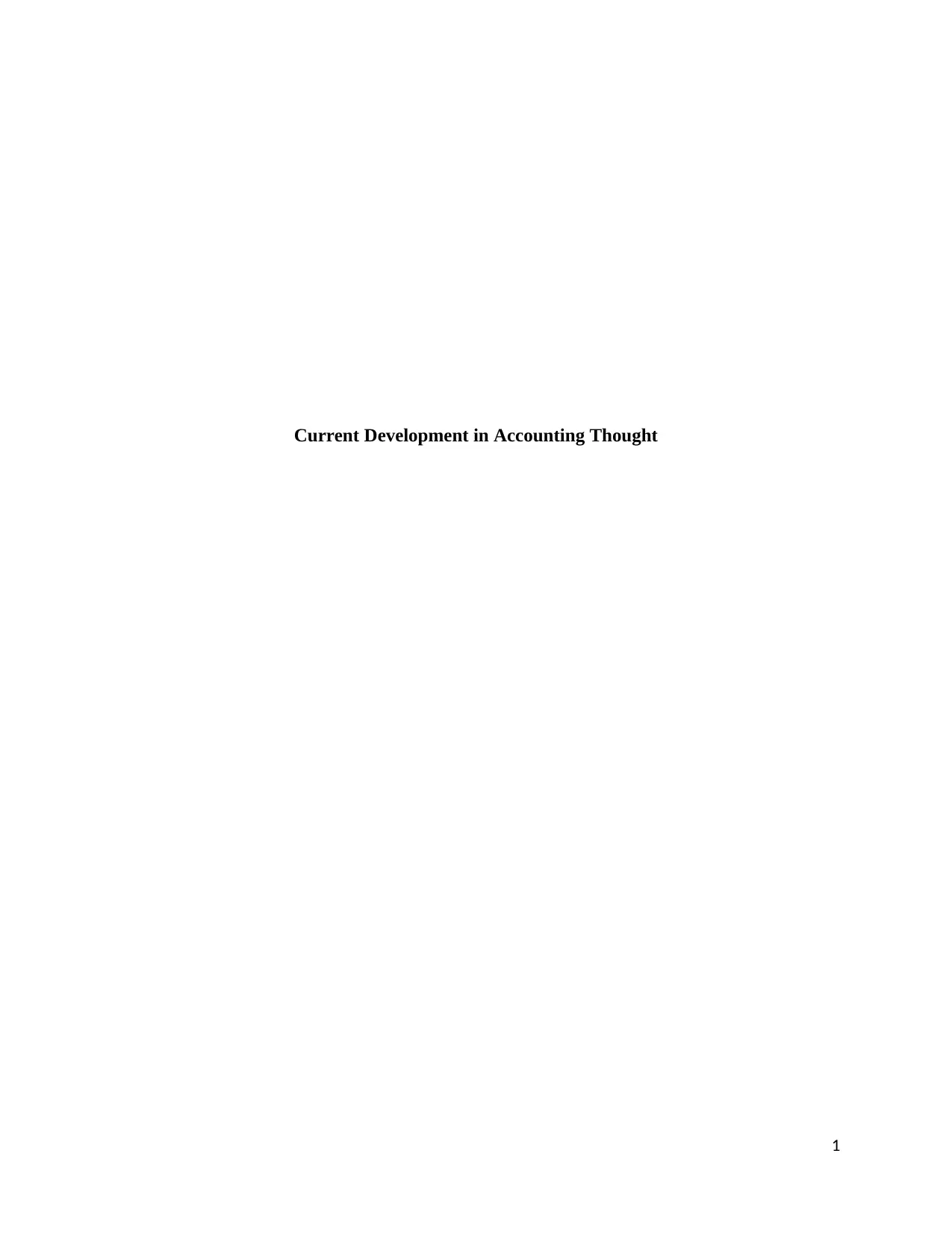
Current Development in Accounting Thought
1
1
Paraphrase This Document
Need a fresh take? Get an instant paraphrase of this document with our AI Paraphraser
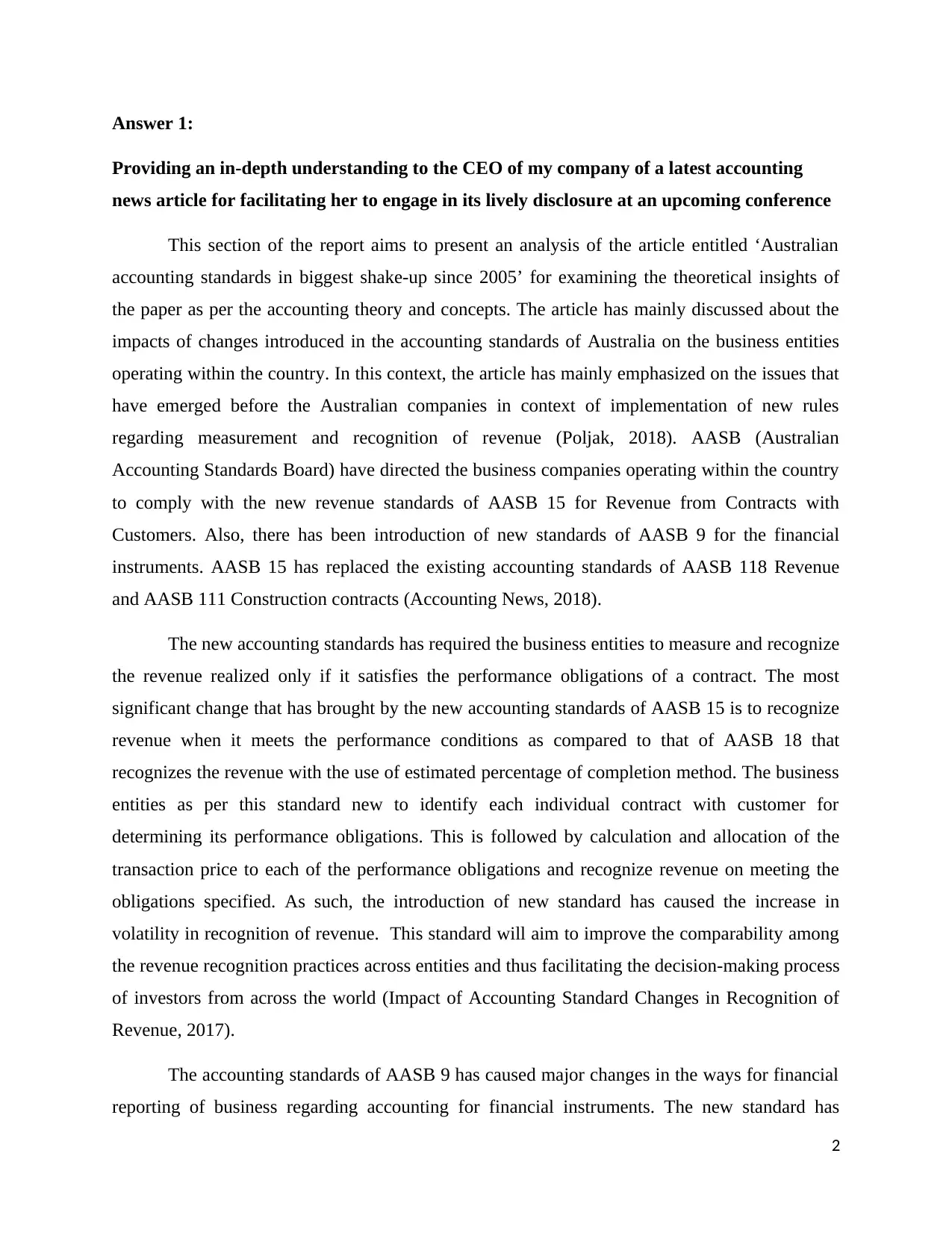
Answer 1:
Providing an in-depth understanding to the CEO of my company of a latest accounting
news article for facilitating her to engage in its lively disclosure at an upcoming conference
This section of the report aims to present an analysis of the article entitled ‘Australian
accounting standards in biggest shake-up since 2005’ for examining the theoretical insights of
the paper as per the accounting theory and concepts. The article has mainly discussed about the
impacts of changes introduced in the accounting standards of Australia on the business entities
operating within the country. In this context, the article has mainly emphasized on the issues that
have emerged before the Australian companies in context of implementation of new rules
regarding measurement and recognition of revenue (Poljak, 2018). AASB (Australian
Accounting Standards Board) have directed the business companies operating within the country
to comply with the new revenue standards of AASB 15 for Revenue from Contracts with
Customers. Also, there has been introduction of new standards of AASB 9 for the financial
instruments. AASB 15 has replaced the existing accounting standards of AASB 118 Revenue
and AASB 111 Construction contracts (Accounting News, 2018).
The new accounting standards has required the business entities to measure and recognize
the revenue realized only if it satisfies the performance obligations of a contract. The most
significant change that has brought by the new accounting standards of AASB 15 is to recognize
revenue when it meets the performance conditions as compared to that of AASB 18 that
recognizes the revenue with the use of estimated percentage of completion method. The business
entities as per this standard new to identify each individual contract with customer for
determining its performance obligations. This is followed by calculation and allocation of the
transaction price to each of the performance obligations and recognize revenue on meeting the
obligations specified. As such, the introduction of new standard has caused the increase in
volatility in recognition of revenue. This standard will aim to improve the comparability among
the revenue recognition practices across entities and thus facilitating the decision-making process
of investors from across the world (Impact of Accounting Standard Changes in Recognition of
Revenue, 2017).
The accounting standards of AASB 9 has caused major changes in the ways for financial
reporting of business regarding accounting for financial instruments. The new standard has
2
Providing an in-depth understanding to the CEO of my company of a latest accounting
news article for facilitating her to engage in its lively disclosure at an upcoming conference
This section of the report aims to present an analysis of the article entitled ‘Australian
accounting standards in biggest shake-up since 2005’ for examining the theoretical insights of
the paper as per the accounting theory and concepts. The article has mainly discussed about the
impacts of changes introduced in the accounting standards of Australia on the business entities
operating within the country. In this context, the article has mainly emphasized on the issues that
have emerged before the Australian companies in context of implementation of new rules
regarding measurement and recognition of revenue (Poljak, 2018). AASB (Australian
Accounting Standards Board) have directed the business companies operating within the country
to comply with the new revenue standards of AASB 15 for Revenue from Contracts with
Customers. Also, there has been introduction of new standards of AASB 9 for the financial
instruments. AASB 15 has replaced the existing accounting standards of AASB 118 Revenue
and AASB 111 Construction contracts (Accounting News, 2018).
The new accounting standards has required the business entities to measure and recognize
the revenue realized only if it satisfies the performance obligations of a contract. The most
significant change that has brought by the new accounting standards of AASB 15 is to recognize
revenue when it meets the performance conditions as compared to that of AASB 18 that
recognizes the revenue with the use of estimated percentage of completion method. The business
entities as per this standard new to identify each individual contract with customer for
determining its performance obligations. This is followed by calculation and allocation of the
transaction price to each of the performance obligations and recognize revenue on meeting the
obligations specified. As such, the introduction of new standard has caused the increase in
volatility in recognition of revenue. This standard will aim to improve the comparability among
the revenue recognition practices across entities and thus facilitating the decision-making process
of investors from across the world (Impact of Accounting Standard Changes in Recognition of
Revenue, 2017).
The accounting standards of AASB 9 has caused major changes in the ways for financial
reporting of business regarding accounting for financial instruments. The new standard has
2
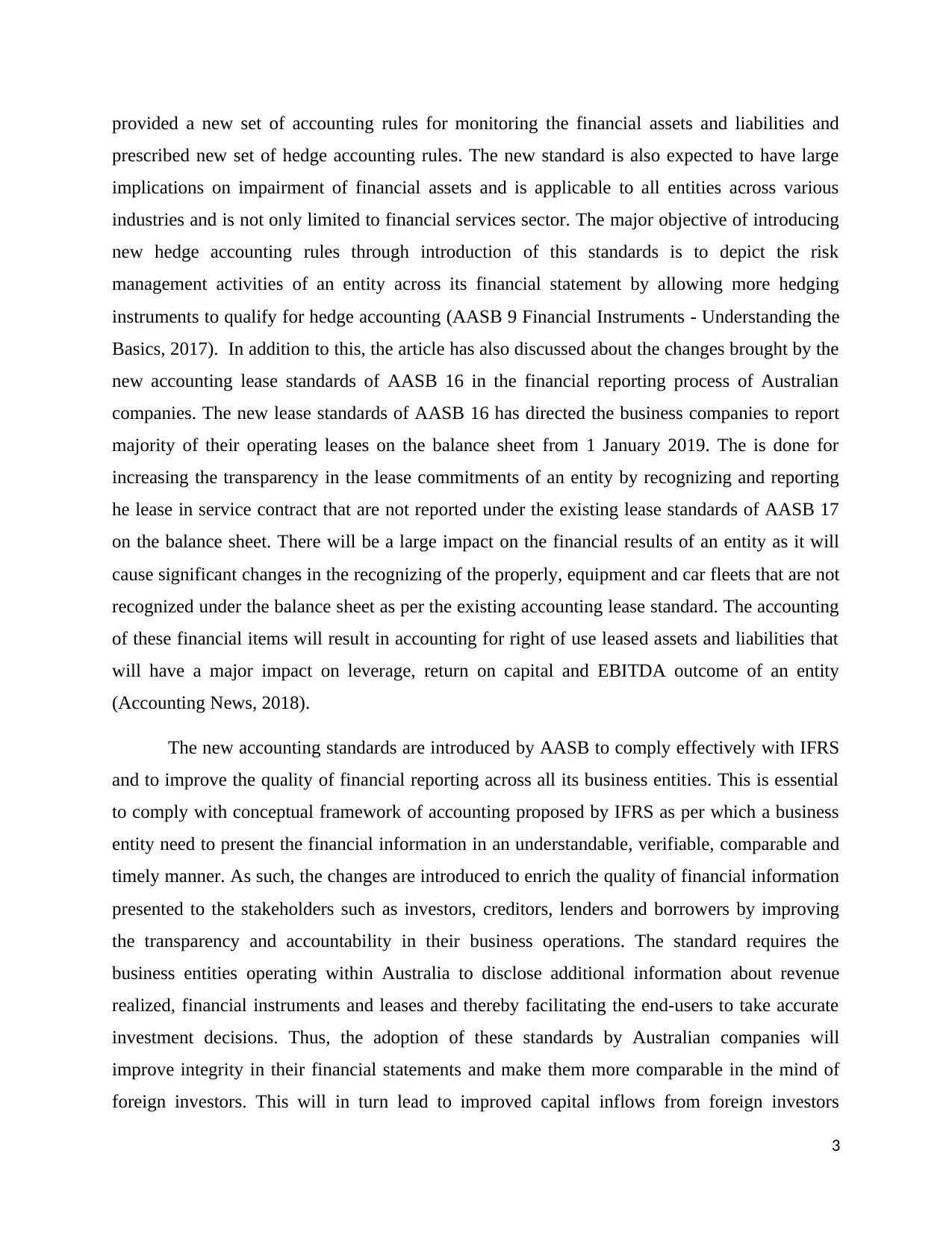
provided a new set of accounting rules for monitoring the financial assets and liabilities and
prescribed new set of hedge accounting rules. The new standard is also expected to have large
implications on impairment of financial assets and is applicable to all entities across various
industries and is not only limited to financial services sector. The major objective of introducing
new hedge accounting rules through introduction of this standards is to depict the risk
management activities of an entity across its financial statement by allowing more hedging
instruments to qualify for hedge accounting (AASB 9 Financial Instruments - Understanding the
Basics, 2017). In addition to this, the article has also discussed about the changes brought by the
new accounting lease standards of AASB 16 in the financial reporting process of Australian
companies. The new lease standards of AASB 16 has directed the business companies to report
majority of their operating leases on the balance sheet from 1 January 2019. The is done for
increasing the transparency in the lease commitments of an entity by recognizing and reporting
he lease in service contract that are not reported under the existing lease standards of AASB 17
on the balance sheet. There will be a large impact on the financial results of an entity as it will
cause significant changes in the recognizing of the properly, equipment and car fleets that are not
recognized under the balance sheet as per the existing accounting lease standard. The accounting
of these financial items will result in accounting for right of use leased assets and liabilities that
will have a major impact on leverage, return on capital and EBITDA outcome of an entity
(Accounting News, 2018).
The new accounting standards are introduced by AASB to comply effectively with IFRS
and to improve the quality of financial reporting across all its business entities. This is essential
to comply with conceptual framework of accounting proposed by IFRS as per which a business
entity need to present the financial information in an understandable, verifiable, comparable and
timely manner. As such, the changes are introduced to enrich the quality of financial information
presented to the stakeholders such as investors, creditors, lenders and borrowers by improving
the transparency and accountability in their business operations. The standard requires the
business entities operating within Australia to disclose additional information about revenue
realized, financial instruments and leases and thereby facilitating the end-users to take accurate
investment decisions. Thus, the adoption of these standards by Australian companies will
improve integrity in their financial statements and make them more comparable in the mind of
foreign investors. This will in turn lead to improved capital inflows from foreign investors
3
prescribed new set of hedge accounting rules. The new standard is also expected to have large
implications on impairment of financial assets and is applicable to all entities across various
industries and is not only limited to financial services sector. The major objective of introducing
new hedge accounting rules through introduction of this standards is to depict the risk
management activities of an entity across its financial statement by allowing more hedging
instruments to qualify for hedge accounting (AASB 9 Financial Instruments - Understanding the
Basics, 2017). In addition to this, the article has also discussed about the changes brought by the
new accounting lease standards of AASB 16 in the financial reporting process of Australian
companies. The new lease standards of AASB 16 has directed the business companies to report
majority of their operating leases on the balance sheet from 1 January 2019. The is done for
increasing the transparency in the lease commitments of an entity by recognizing and reporting
he lease in service contract that are not reported under the existing lease standards of AASB 17
on the balance sheet. There will be a large impact on the financial results of an entity as it will
cause significant changes in the recognizing of the properly, equipment and car fleets that are not
recognized under the balance sheet as per the existing accounting lease standard. The accounting
of these financial items will result in accounting for right of use leased assets and liabilities that
will have a major impact on leverage, return on capital and EBITDA outcome of an entity
(Accounting News, 2018).
The new accounting standards are introduced by AASB to comply effectively with IFRS
and to improve the quality of financial reporting across all its business entities. This is essential
to comply with conceptual framework of accounting proposed by IFRS as per which a business
entity need to present the financial information in an understandable, verifiable, comparable and
timely manner. As such, the changes are introduced to enrich the quality of financial information
presented to the stakeholders such as investors, creditors, lenders and borrowers by improving
the transparency and accountability in their business operations. The standard requires the
business entities operating within Australia to disclose additional information about revenue
realized, financial instruments and leases and thereby facilitating the end-users to take accurate
investment decisions. Thus, the adoption of these standards by Australian companies will
improve integrity in their financial statements and make them more comparable in the mind of
foreign investors. This will in turn lead to improved capital inflows from foreign investors
3
⊘ This is a preview!⊘
Do you want full access?
Subscribe today to unlock all pages.

Trusted by 1+ million students worldwide
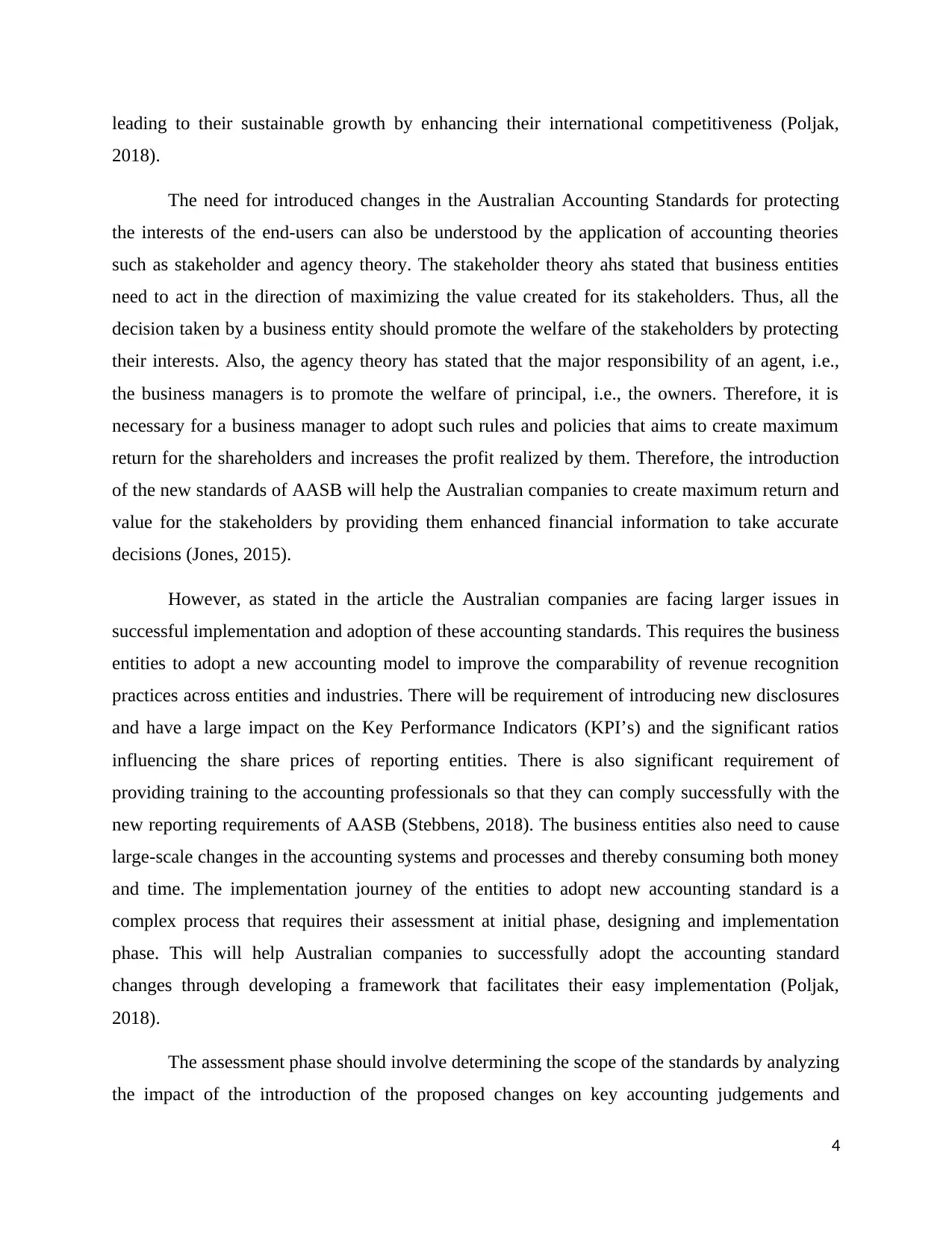
leading to their sustainable growth by enhancing their international competitiveness (Poljak,
2018).
The need for introduced changes in the Australian Accounting Standards for protecting
the interests of the end-users can also be understood by the application of accounting theories
such as stakeholder and agency theory. The stakeholder theory ahs stated that business entities
need to act in the direction of maximizing the value created for its stakeholders. Thus, all the
decision taken by a business entity should promote the welfare of the stakeholders by protecting
their interests. Also, the agency theory has stated that the major responsibility of an agent, i.e.,
the business managers is to promote the welfare of principal, i.e., the owners. Therefore, it is
necessary for a business manager to adopt such rules and policies that aims to create maximum
return for the shareholders and increases the profit realized by them. Therefore, the introduction
of the new standards of AASB will help the Australian companies to create maximum return and
value for the stakeholders by providing them enhanced financial information to take accurate
decisions (Jones, 2015).
However, as stated in the article the Australian companies are facing larger issues in
successful implementation and adoption of these accounting standards. This requires the business
entities to adopt a new accounting model to improve the comparability of revenue recognition
practices across entities and industries. There will be requirement of introducing new disclosures
and have a large impact on the Key Performance Indicators (KPI’s) and the significant ratios
influencing the share prices of reporting entities. There is also significant requirement of
providing training to the accounting professionals so that they can comply successfully with the
new reporting requirements of AASB (Stebbens, 2018). The business entities also need to cause
large-scale changes in the accounting systems and processes and thereby consuming both money
and time. The implementation journey of the entities to adopt new accounting standard is a
complex process that requires their assessment at initial phase, designing and implementation
phase. This will help Australian companies to successfully adopt the accounting standard
changes through developing a framework that facilitates their easy implementation (Poljak,
2018).
The assessment phase should involve determining the scope of the standards by analyzing
the impact of the introduction of the proposed changes on key accounting judgements and
4
2018).
The need for introduced changes in the Australian Accounting Standards for protecting
the interests of the end-users can also be understood by the application of accounting theories
such as stakeholder and agency theory. The stakeholder theory ahs stated that business entities
need to act in the direction of maximizing the value created for its stakeholders. Thus, all the
decision taken by a business entity should promote the welfare of the stakeholders by protecting
their interests. Also, the agency theory has stated that the major responsibility of an agent, i.e.,
the business managers is to promote the welfare of principal, i.e., the owners. Therefore, it is
necessary for a business manager to adopt such rules and policies that aims to create maximum
return for the shareholders and increases the profit realized by them. Therefore, the introduction
of the new standards of AASB will help the Australian companies to create maximum return and
value for the stakeholders by providing them enhanced financial information to take accurate
decisions (Jones, 2015).
However, as stated in the article the Australian companies are facing larger issues in
successful implementation and adoption of these accounting standards. This requires the business
entities to adopt a new accounting model to improve the comparability of revenue recognition
practices across entities and industries. There will be requirement of introducing new disclosures
and have a large impact on the Key Performance Indicators (KPI’s) and the significant ratios
influencing the share prices of reporting entities. There is also significant requirement of
providing training to the accounting professionals so that they can comply successfully with the
new reporting requirements of AASB (Stebbens, 2018). The business entities also need to cause
large-scale changes in the accounting systems and processes and thereby consuming both money
and time. The implementation journey of the entities to adopt new accounting standard is a
complex process that requires their assessment at initial phase, designing and implementation
phase. This will help Australian companies to successfully adopt the accounting standard
changes through developing a framework that facilitates their easy implementation (Poljak,
2018).
The assessment phase should involve determining the scope of the standards by analyzing
the impact of the introduction of the proposed changes on key accounting judgements and
4
Paraphrase This Document
Need a fresh take? Get an instant paraphrase of this document with our AI Paraphraser
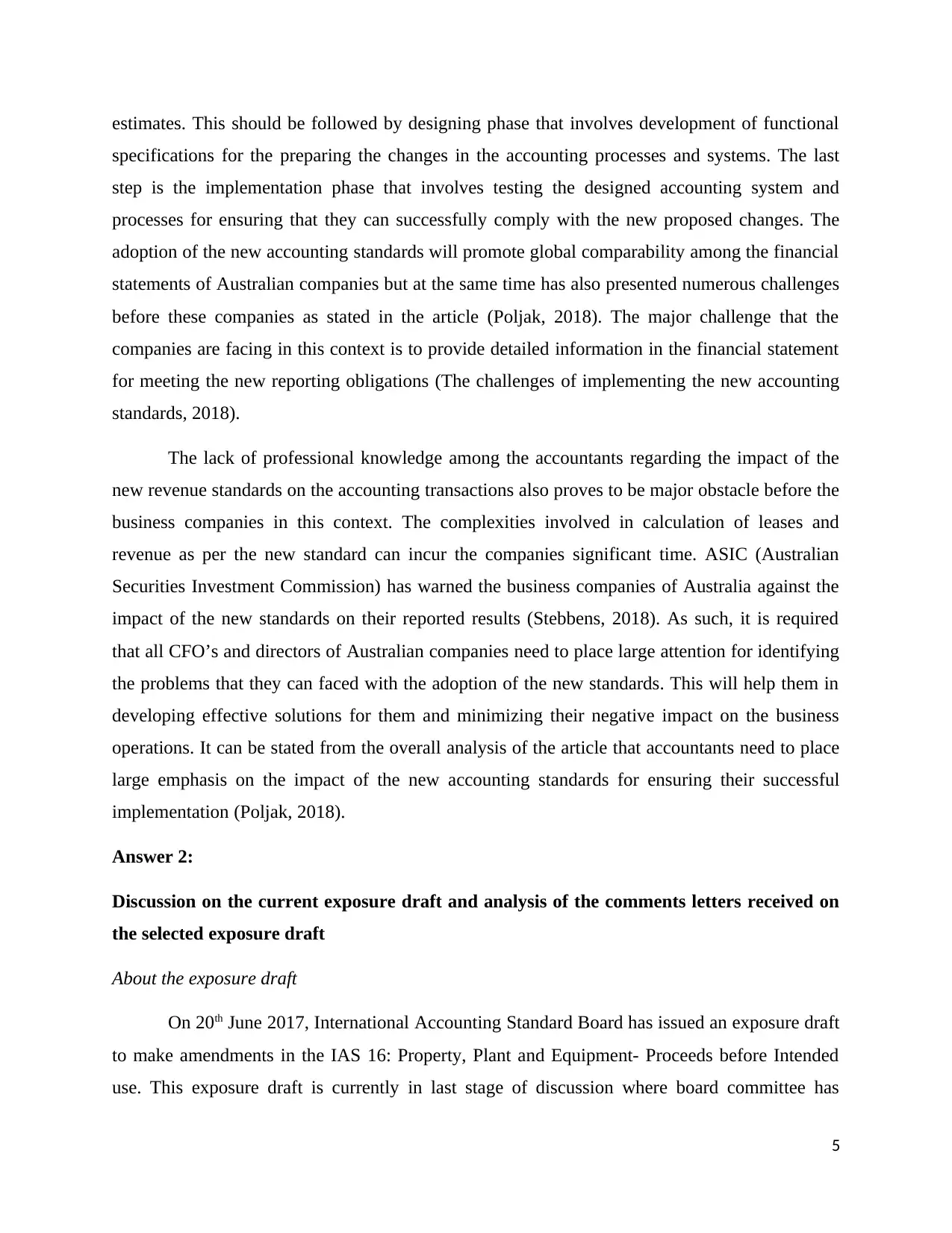
estimates. This should be followed by designing phase that involves development of functional
specifications for the preparing the changes in the accounting processes and systems. The last
step is the implementation phase that involves testing the designed accounting system and
processes for ensuring that they can successfully comply with the new proposed changes. The
adoption of the new accounting standards will promote global comparability among the financial
statements of Australian companies but at the same time has also presented numerous challenges
before these companies as stated in the article (Poljak, 2018). The major challenge that the
companies are facing in this context is to provide detailed information in the financial statement
for meeting the new reporting obligations (The challenges of implementing the new accounting
standards, 2018).
The lack of professional knowledge among the accountants regarding the impact of the
new revenue standards on the accounting transactions also proves to be major obstacle before the
business companies in this context. The complexities involved in calculation of leases and
revenue as per the new standard can incur the companies significant time. ASIC (Australian
Securities Investment Commission) has warned the business companies of Australia against the
impact of the new standards on their reported results (Stebbens, 2018). As such, it is required
that all CFO’s and directors of Australian companies need to place large attention for identifying
the problems that they can faced with the adoption of the new standards. This will help them in
developing effective solutions for them and minimizing their negative impact on the business
operations. It can be stated from the overall analysis of the article that accountants need to place
large emphasis on the impact of the new accounting standards for ensuring their successful
implementation (Poljak, 2018).
Answer 2:
Discussion on the current exposure draft and analysis of the comments letters received on
the selected exposure draft
About the exposure draft
On 20th June 2017, International Accounting Standard Board has issued an exposure draft
to make amendments in the IAS 16: Property, Plant and Equipment- Proceeds before Intended
use. This exposure draft is currently in last stage of discussion where board committee has
5
specifications for the preparing the changes in the accounting processes and systems. The last
step is the implementation phase that involves testing the designed accounting system and
processes for ensuring that they can successfully comply with the new proposed changes. The
adoption of the new accounting standards will promote global comparability among the financial
statements of Australian companies but at the same time has also presented numerous challenges
before these companies as stated in the article (Poljak, 2018). The major challenge that the
companies are facing in this context is to provide detailed information in the financial statement
for meeting the new reporting obligations (The challenges of implementing the new accounting
standards, 2018).
The lack of professional knowledge among the accountants regarding the impact of the
new revenue standards on the accounting transactions also proves to be major obstacle before the
business companies in this context. The complexities involved in calculation of leases and
revenue as per the new standard can incur the companies significant time. ASIC (Australian
Securities Investment Commission) has warned the business companies of Australia against the
impact of the new standards on their reported results (Stebbens, 2018). As such, it is required
that all CFO’s and directors of Australian companies need to place large attention for identifying
the problems that they can faced with the adoption of the new standards. This will help them in
developing effective solutions for them and minimizing their negative impact on the business
operations. It can be stated from the overall analysis of the article that accountants need to place
large emphasis on the impact of the new accounting standards for ensuring their successful
implementation (Poljak, 2018).
Answer 2:
Discussion on the current exposure draft and analysis of the comments letters received on
the selected exposure draft
About the exposure draft
On 20th June 2017, International Accounting Standard Board has issued an exposure draft
to make amendments in the IAS 16: Property, Plant and Equipment- Proceeds before Intended
use. This exposure draft is currently in last stage of discussion where board committee has
5
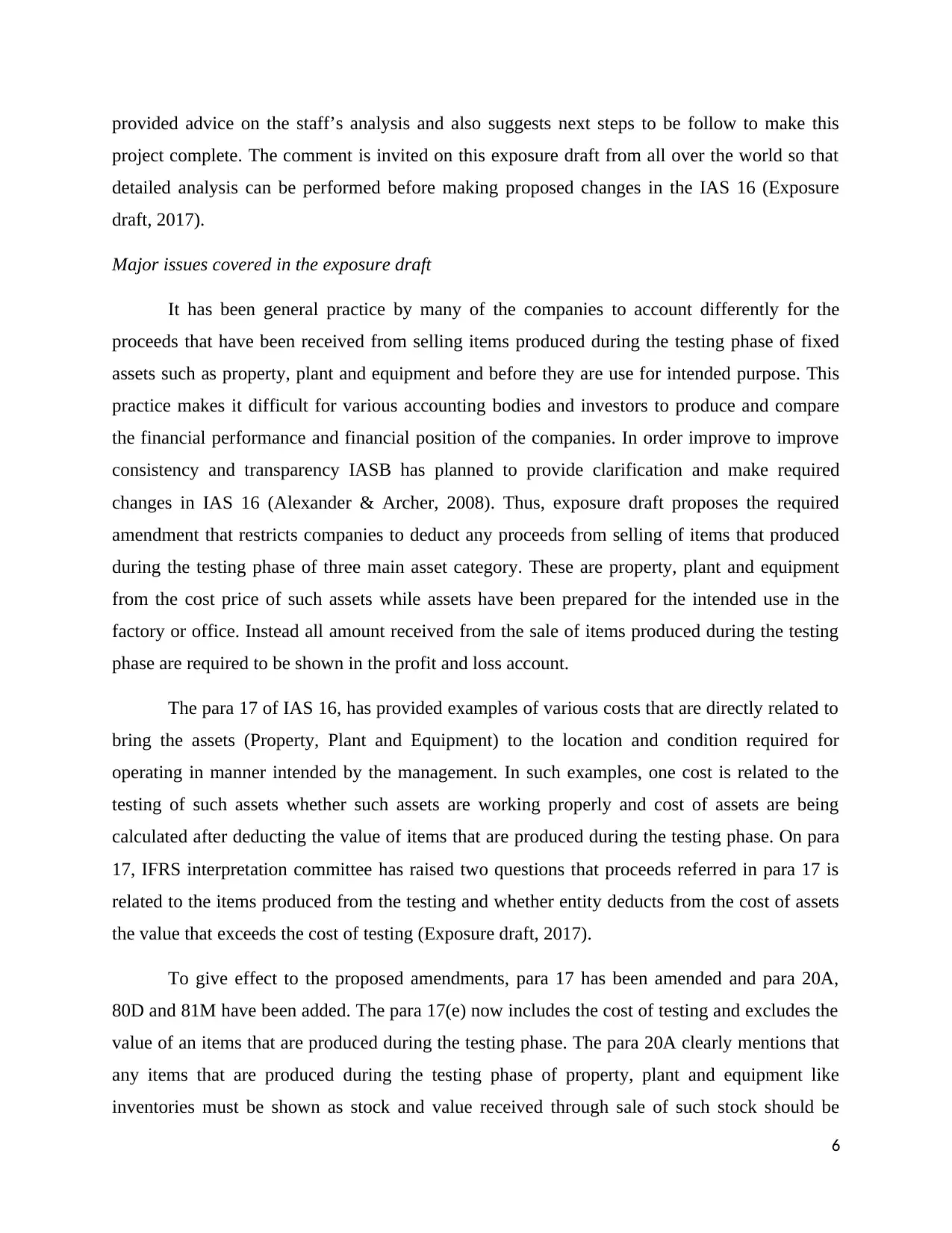
provided advice on the staff’s analysis and also suggests next steps to be follow to make this
project complete. The comment is invited on this exposure draft from all over the world so that
detailed analysis can be performed before making proposed changes in the IAS 16 (Exposure
draft, 2017).
Major issues covered in the exposure draft
It has been general practice by many of the companies to account differently for the
proceeds that have been received from selling items produced during the testing phase of fixed
assets such as property, plant and equipment and before they are use for intended purpose. This
practice makes it difficult for various accounting bodies and investors to produce and compare
the financial performance and financial position of the companies. In order improve to improve
consistency and transparency IASB has planned to provide clarification and make required
changes in IAS 16 (Alexander & Archer, 2008). Thus, exposure draft proposes the required
amendment that restricts companies to deduct any proceeds from selling of items that produced
during the testing phase of three main asset category. These are property, plant and equipment
from the cost price of such assets while assets have been prepared for the intended use in the
factory or office. Instead all amount received from the sale of items produced during the testing
phase are required to be shown in the profit and loss account.
The para 17 of IAS 16, has provided examples of various costs that are directly related to
bring the assets (Property, Plant and Equipment) to the location and condition required for
operating in manner intended by the management. In such examples, one cost is related to the
testing of such assets whether such assets are working properly and cost of assets are being
calculated after deducting the value of items that are produced during the testing phase. On para
17, IFRS interpretation committee has raised two questions that proceeds referred in para 17 is
related to the items produced from the testing and whether entity deducts from the cost of assets
the value that exceeds the cost of testing (Exposure draft, 2017).
To give effect to the proposed amendments, para 17 has been amended and para 20A,
80D and 81M have been added. The para 17(e) now includes the cost of testing and excludes the
value of an items that are produced during the testing phase. The para 20A clearly mentions that
any items that are produced during the testing phase of property, plant and equipment like
inventories must be shown as stock and value received through sale of such stock should be
6
project complete. The comment is invited on this exposure draft from all over the world so that
detailed analysis can be performed before making proposed changes in the IAS 16 (Exposure
draft, 2017).
Major issues covered in the exposure draft
It has been general practice by many of the companies to account differently for the
proceeds that have been received from selling items produced during the testing phase of fixed
assets such as property, plant and equipment and before they are use for intended purpose. This
practice makes it difficult for various accounting bodies and investors to produce and compare
the financial performance and financial position of the companies. In order improve to improve
consistency and transparency IASB has planned to provide clarification and make required
changes in IAS 16 (Alexander & Archer, 2008). Thus, exposure draft proposes the required
amendment that restricts companies to deduct any proceeds from selling of items that produced
during the testing phase of three main asset category. These are property, plant and equipment
from the cost price of such assets while assets have been prepared for the intended use in the
factory or office. Instead all amount received from the sale of items produced during the testing
phase are required to be shown in the profit and loss account.
The para 17 of IAS 16, has provided examples of various costs that are directly related to
bring the assets (Property, Plant and Equipment) to the location and condition required for
operating in manner intended by the management. In such examples, one cost is related to the
testing of such assets whether such assets are working properly and cost of assets are being
calculated after deducting the value of items that are produced during the testing phase. On para
17, IFRS interpretation committee has raised two questions that proceeds referred in para 17 is
related to the items produced from the testing and whether entity deducts from the cost of assets
the value that exceeds the cost of testing (Exposure draft, 2017).
To give effect to the proposed amendments, para 17 has been amended and para 20A,
80D and 81M have been added. The para 17(e) now includes the cost of testing and excludes the
value of an items that are produced during the testing phase. The para 20A clearly mentions that
any items that are produced during the testing phase of property, plant and equipment like
inventories must be shown as stock and value received through sale of such stock should be
6
⊘ This is a preview!⊘
Do you want full access?
Subscribe today to unlock all pages.

Trusted by 1+ million students worldwide
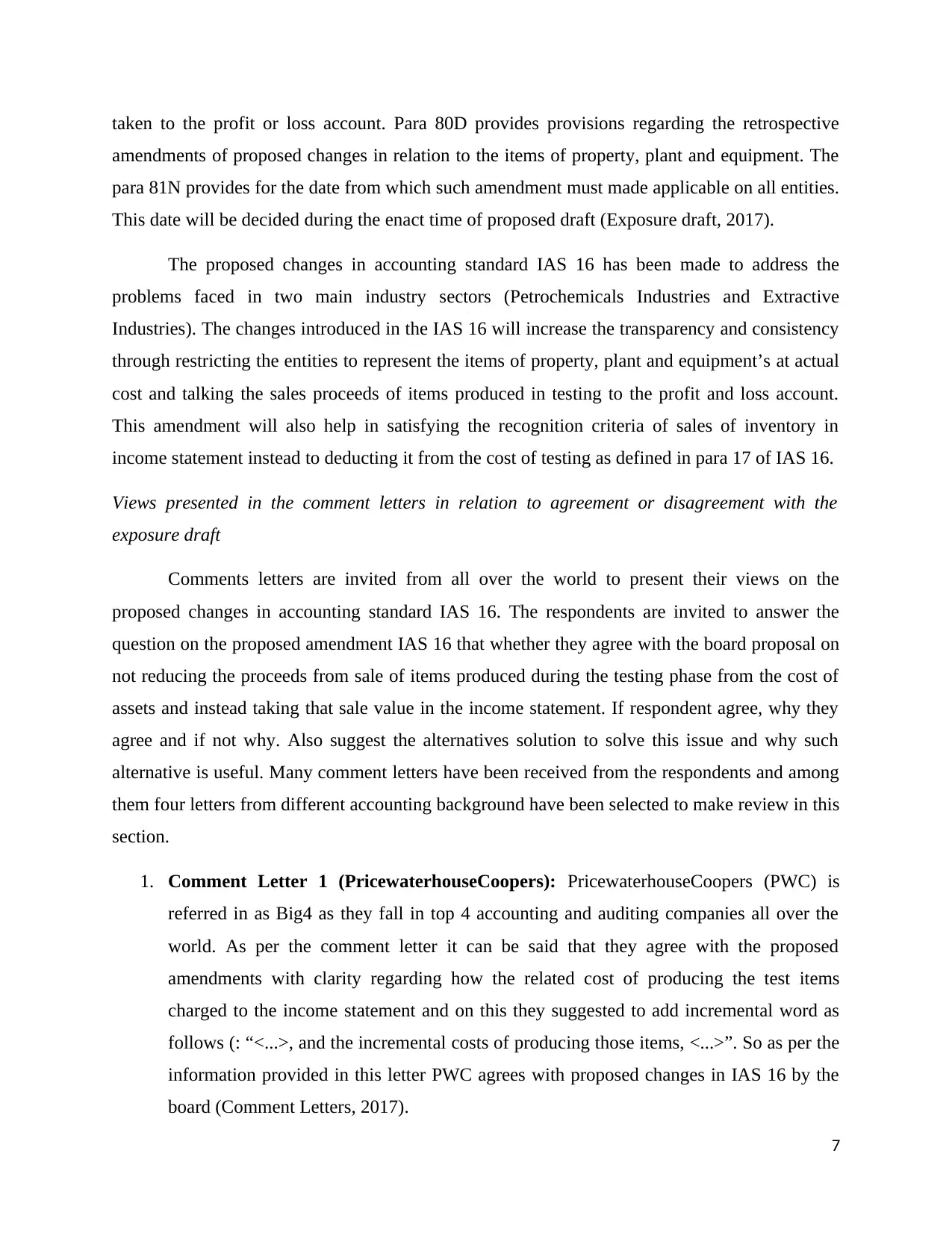
taken to the profit or loss account. Para 80D provides provisions regarding the retrospective
amendments of proposed changes in relation to the items of property, plant and equipment. The
para 81N provides for the date from which such amendment must made applicable on all entities.
This date will be decided during the enact time of proposed draft (Exposure draft, 2017).
The proposed changes in accounting standard IAS 16 has been made to address the
problems faced in two main industry sectors (Petrochemicals Industries and Extractive
Industries). The changes introduced in the IAS 16 will increase the transparency and consistency
through restricting the entities to represent the items of property, plant and equipment’s at actual
cost and talking the sales proceeds of items produced in testing to the profit and loss account.
This amendment will also help in satisfying the recognition criteria of sales of inventory in
income statement instead to deducting it from the cost of testing as defined in para 17 of IAS 16.
Views presented in the comment letters in relation to agreement or disagreement with the
exposure draft
Comments letters are invited from all over the world to present their views on the
proposed changes in accounting standard IAS 16. The respondents are invited to answer the
question on the proposed amendment IAS 16 that whether they agree with the board proposal on
not reducing the proceeds from sale of items produced during the testing phase from the cost of
assets and instead taking that sale value in the income statement. If respondent agree, why they
agree and if not why. Also suggest the alternatives solution to solve this issue and why such
alternative is useful. Many comment letters have been received from the respondents and among
them four letters from different accounting background have been selected to make review in this
section.
1. Comment Letter 1 (PricewaterhouseCoopers): PricewaterhouseCoopers (PWC) is
referred in as Big4 as they fall in top 4 accounting and auditing companies all over the
world. As per the comment letter it can be said that they agree with the proposed
amendments with clarity regarding how the related cost of producing the test items
charged to the income statement and on this they suggested to add incremental word as
follows (: “<...>, and the incremental costs of producing those items, <...>”. So as per the
information provided in this letter PWC agrees with proposed changes in IAS 16 by the
board (Comment Letters, 2017).
7
amendments of proposed changes in relation to the items of property, plant and equipment. The
para 81N provides for the date from which such amendment must made applicable on all entities.
This date will be decided during the enact time of proposed draft (Exposure draft, 2017).
The proposed changes in accounting standard IAS 16 has been made to address the
problems faced in two main industry sectors (Petrochemicals Industries and Extractive
Industries). The changes introduced in the IAS 16 will increase the transparency and consistency
through restricting the entities to represent the items of property, plant and equipment’s at actual
cost and talking the sales proceeds of items produced in testing to the profit and loss account.
This amendment will also help in satisfying the recognition criteria of sales of inventory in
income statement instead to deducting it from the cost of testing as defined in para 17 of IAS 16.
Views presented in the comment letters in relation to agreement or disagreement with the
exposure draft
Comments letters are invited from all over the world to present their views on the
proposed changes in accounting standard IAS 16. The respondents are invited to answer the
question on the proposed amendment IAS 16 that whether they agree with the board proposal on
not reducing the proceeds from sale of items produced during the testing phase from the cost of
assets and instead taking that sale value in the income statement. If respondent agree, why they
agree and if not why. Also suggest the alternatives solution to solve this issue and why such
alternative is useful. Many comment letters have been received from the respondents and among
them four letters from different accounting background have been selected to make review in this
section.
1. Comment Letter 1 (PricewaterhouseCoopers): PricewaterhouseCoopers (PWC) is
referred in as Big4 as they fall in top 4 accounting and auditing companies all over the
world. As per the comment letter it can be said that they agree with the proposed
amendments with clarity regarding how the related cost of producing the test items
charged to the income statement and on this they suggested to add incremental word as
follows (: “<...>, and the incremental costs of producing those items, <...>”. So as per the
information provided in this letter PWC agrees with proposed changes in IAS 16 by the
board (Comment Letters, 2017).
7
Paraphrase This Document
Need a fresh take? Get an instant paraphrase of this document with our AI Paraphraser
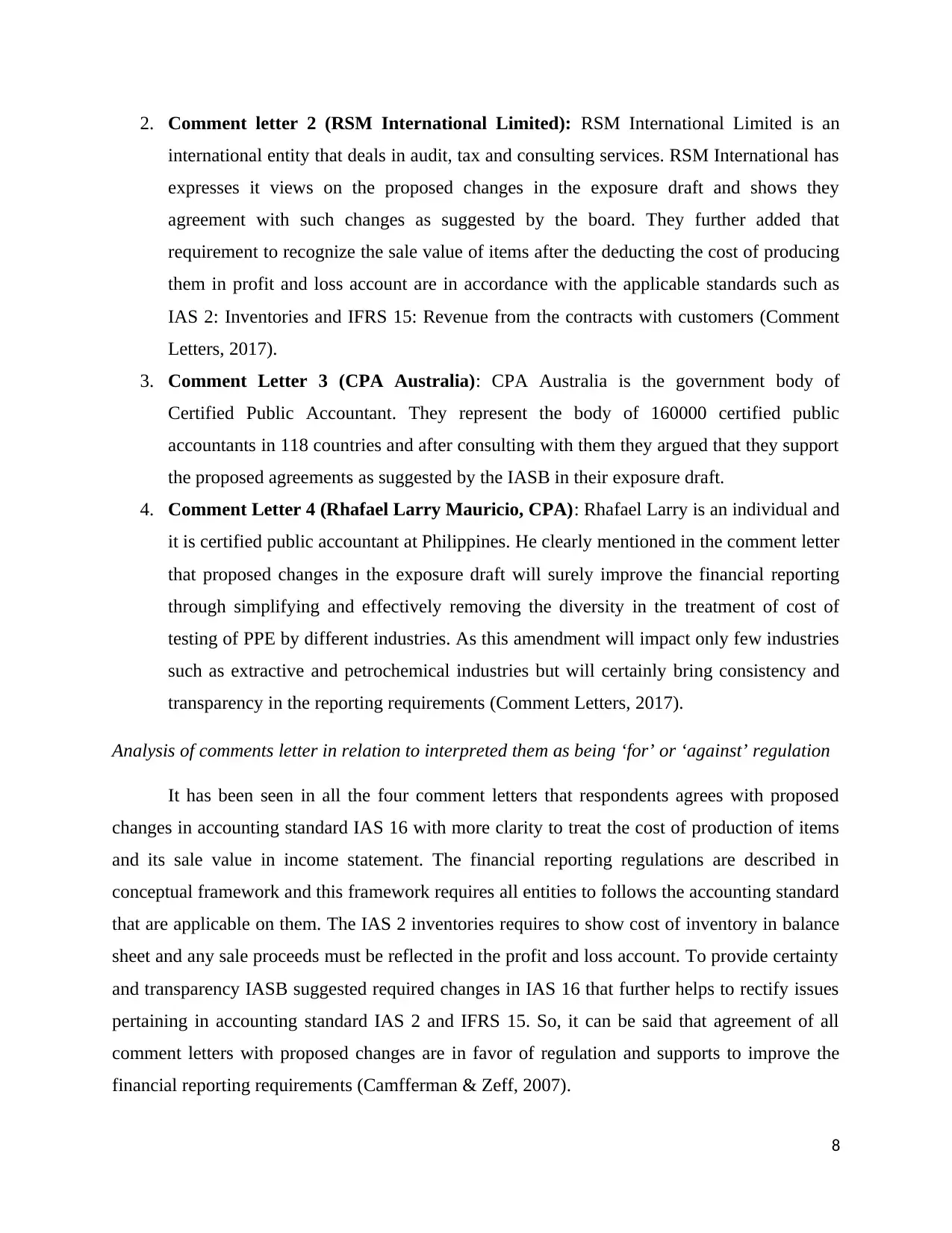
2. Comment letter 2 (RSM International Limited): RSM International Limited is an
international entity that deals in audit, tax and consulting services. RSM International has
expresses it views on the proposed changes in the exposure draft and shows they
agreement with such changes as suggested by the board. They further added that
requirement to recognize the sale value of items after the deducting the cost of producing
them in profit and loss account are in accordance with the applicable standards such as
IAS 2: Inventories and IFRS 15: Revenue from the contracts with customers (Comment
Letters, 2017).
3. Comment Letter 3 (CPA Australia): CPA Australia is the government body of
Certified Public Accountant. They represent the body of 160000 certified public
accountants in 118 countries and after consulting with them they argued that they support
the proposed agreements as suggested by the IASB in their exposure draft.
4. Comment Letter 4 (Rhafael Larry Mauricio, CPA): Rhafael Larry is an individual and
it is certified public accountant at Philippines. He clearly mentioned in the comment letter
that proposed changes in the exposure draft will surely improve the financial reporting
through simplifying and effectively removing the diversity in the treatment of cost of
testing of PPE by different industries. As this amendment will impact only few industries
such as extractive and petrochemical industries but will certainly bring consistency and
transparency in the reporting requirements (Comment Letters, 2017).
Analysis of comments letter in relation to interpreted them as being ‘for’ or ‘against’ regulation
It has been seen in all the four comment letters that respondents agrees with proposed
changes in accounting standard IAS 16 with more clarity to treat the cost of production of items
and its sale value in income statement. The financial reporting regulations are described in
conceptual framework and this framework requires all entities to follows the accounting standard
that are applicable on them. The IAS 2 inventories requires to show cost of inventory in balance
sheet and any sale proceeds must be reflected in the profit and loss account. To provide certainty
and transparency IASB suggested required changes in IAS 16 that further helps to rectify issues
pertaining in accounting standard IAS 2 and IFRS 15. So, it can be said that agreement of all
comment letters with proposed changes are in favor of regulation and supports to improve the
financial reporting requirements (Camfferman & Zeff, 2007).
8
international entity that deals in audit, tax and consulting services. RSM International has
expresses it views on the proposed changes in the exposure draft and shows they
agreement with such changes as suggested by the board. They further added that
requirement to recognize the sale value of items after the deducting the cost of producing
them in profit and loss account are in accordance with the applicable standards such as
IAS 2: Inventories and IFRS 15: Revenue from the contracts with customers (Comment
Letters, 2017).
3. Comment Letter 3 (CPA Australia): CPA Australia is the government body of
Certified Public Accountant. They represent the body of 160000 certified public
accountants in 118 countries and after consulting with them they argued that they support
the proposed agreements as suggested by the IASB in their exposure draft.
4. Comment Letter 4 (Rhafael Larry Mauricio, CPA): Rhafael Larry is an individual and
it is certified public accountant at Philippines. He clearly mentioned in the comment letter
that proposed changes in the exposure draft will surely improve the financial reporting
through simplifying and effectively removing the diversity in the treatment of cost of
testing of PPE by different industries. As this amendment will impact only few industries
such as extractive and petrochemical industries but will certainly bring consistency and
transparency in the reporting requirements (Comment Letters, 2017).
Analysis of comments letter in relation to interpreted them as being ‘for’ or ‘against’ regulation
It has been seen in all the four comment letters that respondents agrees with proposed
changes in accounting standard IAS 16 with more clarity to treat the cost of production of items
and its sale value in income statement. The financial reporting regulations are described in
conceptual framework and this framework requires all entities to follows the accounting standard
that are applicable on them. The IAS 2 inventories requires to show cost of inventory in balance
sheet and any sale proceeds must be reflected in the profit and loss account. To provide certainty
and transparency IASB suggested required changes in IAS 16 that further helps to rectify issues
pertaining in accounting standard IAS 2 and IFRS 15. So, it can be said that agreement of all
comment letters with proposed changes are in favor of regulation and supports to improve the
financial reporting requirements (Camfferman & Zeff, 2007).
8
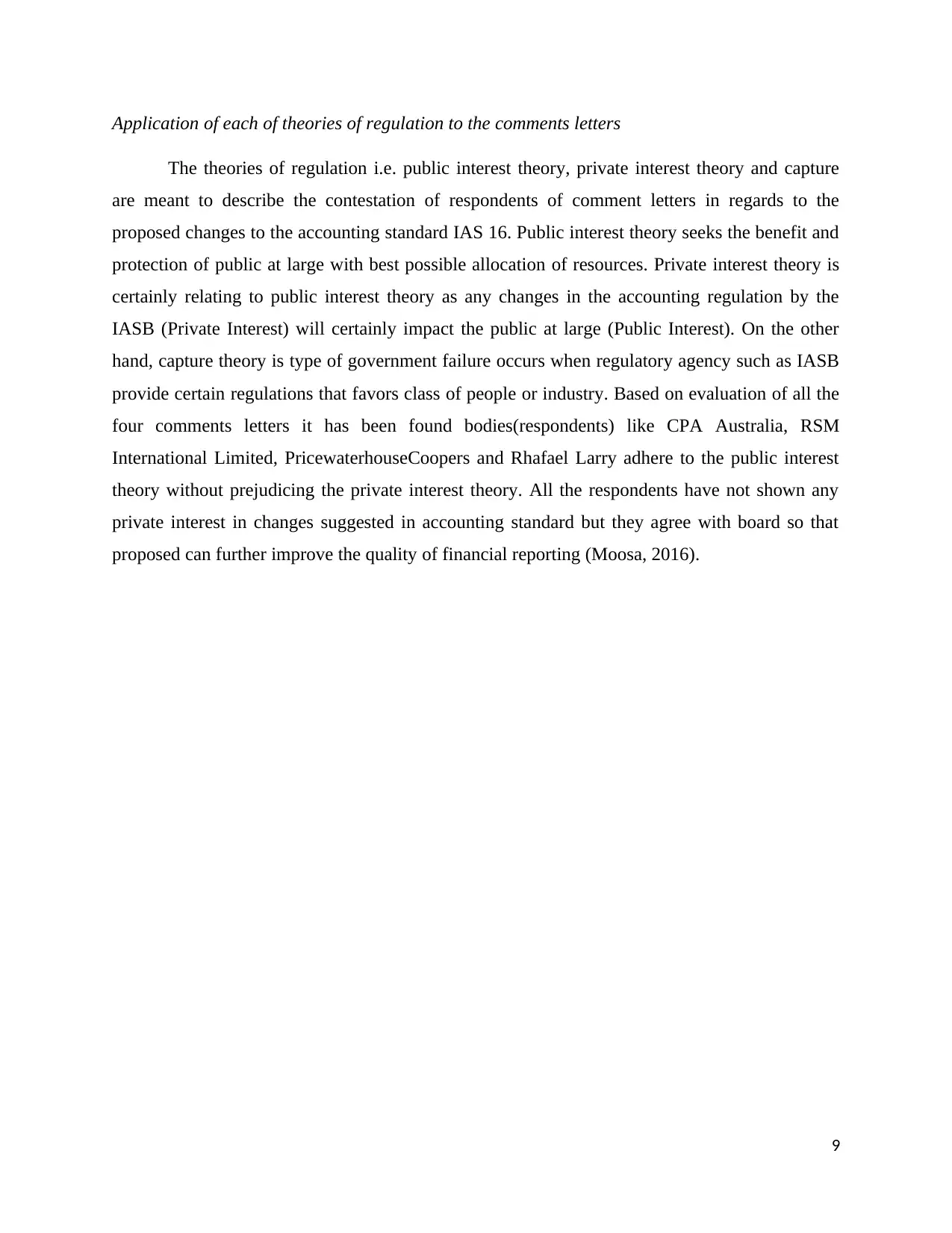
Application of each of theories of regulation to the comments letters
The theories of regulation i.e. public interest theory, private interest theory and capture
are meant to describe the contestation of respondents of comment letters in regards to the
proposed changes to the accounting standard IAS 16. Public interest theory seeks the benefit and
protection of public at large with best possible allocation of resources. Private interest theory is
certainly relating to public interest theory as any changes in the accounting regulation by the
IASB (Private Interest) will certainly impact the public at large (Public Interest). On the other
hand, capture theory is type of government failure occurs when regulatory agency such as IASB
provide certain regulations that favors class of people or industry. Based on evaluation of all the
four comments letters it has been found bodies(respondents) like CPA Australia, RSM
International Limited, PricewaterhouseCoopers and Rhafael Larry adhere to the public interest
theory without prejudicing the private interest theory. All the respondents have not shown any
private interest in changes suggested in accounting standard but they agree with board so that
proposed can further improve the quality of financial reporting (Moosa, 2016).
9
The theories of regulation i.e. public interest theory, private interest theory and capture
are meant to describe the contestation of respondents of comment letters in regards to the
proposed changes to the accounting standard IAS 16. Public interest theory seeks the benefit and
protection of public at large with best possible allocation of resources. Private interest theory is
certainly relating to public interest theory as any changes in the accounting regulation by the
IASB (Private Interest) will certainly impact the public at large (Public Interest). On the other
hand, capture theory is type of government failure occurs when regulatory agency such as IASB
provide certain regulations that favors class of people or industry. Based on evaluation of all the
four comments letters it has been found bodies(respondents) like CPA Australia, RSM
International Limited, PricewaterhouseCoopers and Rhafael Larry adhere to the public interest
theory without prejudicing the private interest theory. All the respondents have not shown any
private interest in changes suggested in accounting standard but they agree with board so that
proposed can further improve the quality of financial reporting (Moosa, 2016).
9
⊘ This is a preview!⊘
Do you want full access?
Subscribe today to unlock all pages.

Trusted by 1+ million students worldwide
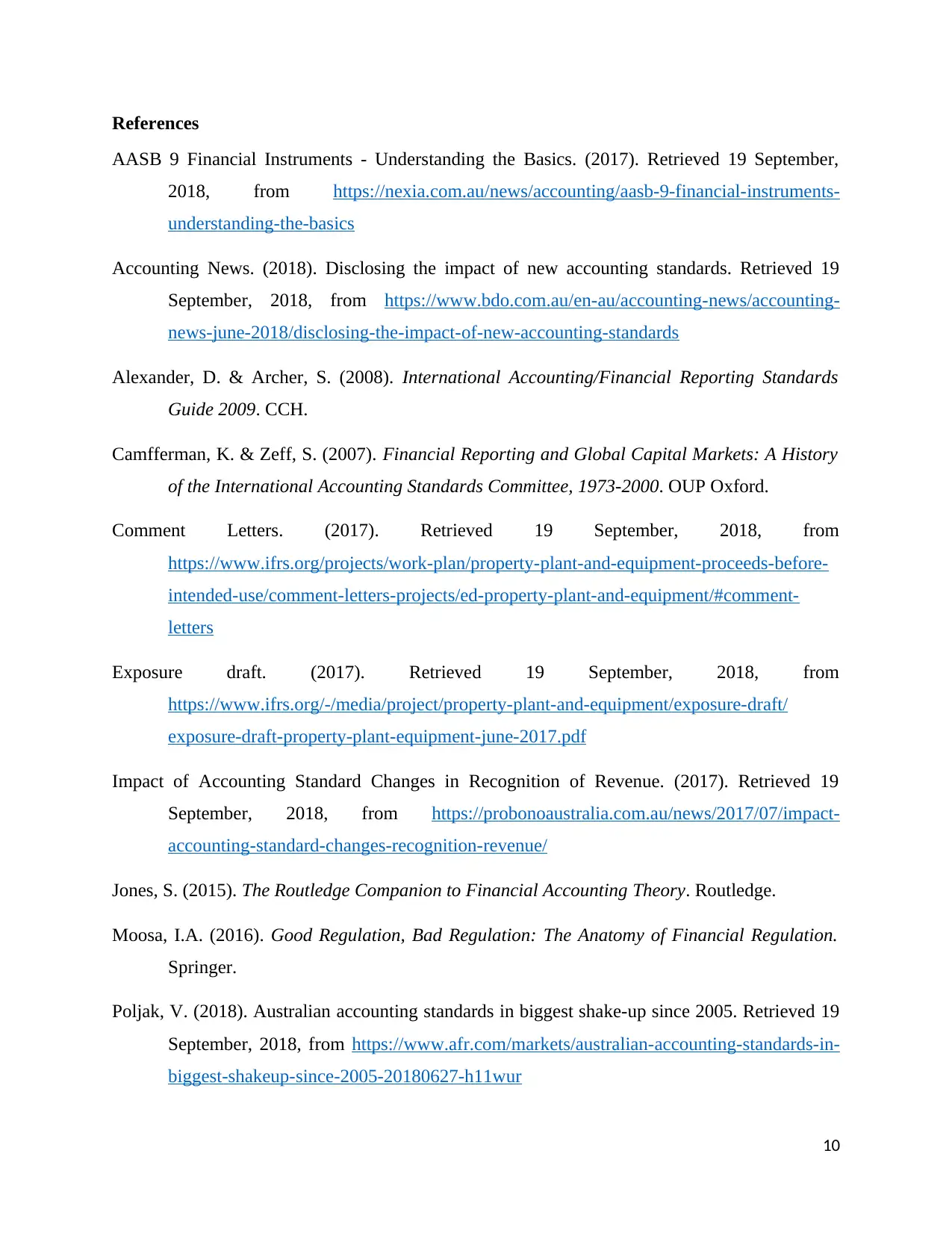
References
AASB 9 Financial Instruments - Understanding the Basics. (2017). Retrieved 19 September,
2018, from https://nexia.com.au/news/accounting/aasb-9-financial-instruments-
understanding-the-basics
Accounting News. (2018). Disclosing the impact of new accounting standards. Retrieved 19
September, 2018, from https://www.bdo.com.au/en-au/accounting-news/accounting-
news-june-2018/disclosing-the-impact-of-new-accounting-standards
Alexander, D. & Archer, S. (2008). International Accounting/Financial Reporting Standards
Guide 2009. CCH.
Camfferman, K. & Zeff, S. (2007). Financial Reporting and Global Capital Markets: A History
of the International Accounting Standards Committee, 1973-2000. OUP Oxford.
Comment Letters. (2017). Retrieved 19 September, 2018, from
https://www.ifrs.org/projects/work-plan/property-plant-and-equipment-proceeds-before-
intended-use/comment-letters-projects/ed-property-plant-and-equipment/#comment-
letters
Exposure draft. (2017). Retrieved 19 September, 2018, from
https://www.ifrs.org/-/media/project/property-plant-and-equipment/exposure-draft/
exposure-draft-property-plant-equipment-june-2017.pdf
Impact of Accounting Standard Changes in Recognition of Revenue. (2017). Retrieved 19
September, 2018, from https://probonoaustralia.com.au/news/2017/07/impact-
accounting-standard-changes-recognition-revenue/
Jones, S. (2015). The Routledge Companion to Financial Accounting Theory. Routledge.
Moosa, I.A. (2016). Good Regulation, Bad Regulation: The Anatomy of Financial Regulation.
Springer.
Poljak, V. (2018). Australian accounting standards in biggest shake-up since 2005. Retrieved 19
September, 2018, from https://www.afr.com/markets/australian-accounting-standards-in-
biggest-shakeup-since-2005-20180627-h11wur
10
AASB 9 Financial Instruments - Understanding the Basics. (2017). Retrieved 19 September,
2018, from https://nexia.com.au/news/accounting/aasb-9-financial-instruments-
understanding-the-basics
Accounting News. (2018). Disclosing the impact of new accounting standards. Retrieved 19
September, 2018, from https://www.bdo.com.au/en-au/accounting-news/accounting-
news-june-2018/disclosing-the-impact-of-new-accounting-standards
Alexander, D. & Archer, S. (2008). International Accounting/Financial Reporting Standards
Guide 2009. CCH.
Camfferman, K. & Zeff, S. (2007). Financial Reporting and Global Capital Markets: A History
of the International Accounting Standards Committee, 1973-2000. OUP Oxford.
Comment Letters. (2017). Retrieved 19 September, 2018, from
https://www.ifrs.org/projects/work-plan/property-plant-and-equipment-proceeds-before-
intended-use/comment-letters-projects/ed-property-plant-and-equipment/#comment-
letters
Exposure draft. (2017). Retrieved 19 September, 2018, from
https://www.ifrs.org/-/media/project/property-plant-and-equipment/exposure-draft/
exposure-draft-property-plant-equipment-june-2017.pdf
Impact of Accounting Standard Changes in Recognition of Revenue. (2017). Retrieved 19
September, 2018, from https://probonoaustralia.com.au/news/2017/07/impact-
accounting-standard-changes-recognition-revenue/
Jones, S. (2015). The Routledge Companion to Financial Accounting Theory. Routledge.
Moosa, I.A. (2016). Good Regulation, Bad Regulation: The Anatomy of Financial Regulation.
Springer.
Poljak, V. (2018). Australian accounting standards in biggest shake-up since 2005. Retrieved 19
September, 2018, from https://www.afr.com/markets/australian-accounting-standards-in-
biggest-shakeup-since-2005-20180627-h11wur
10
Paraphrase This Document
Need a fresh take? Get an instant paraphrase of this document with our AI Paraphraser
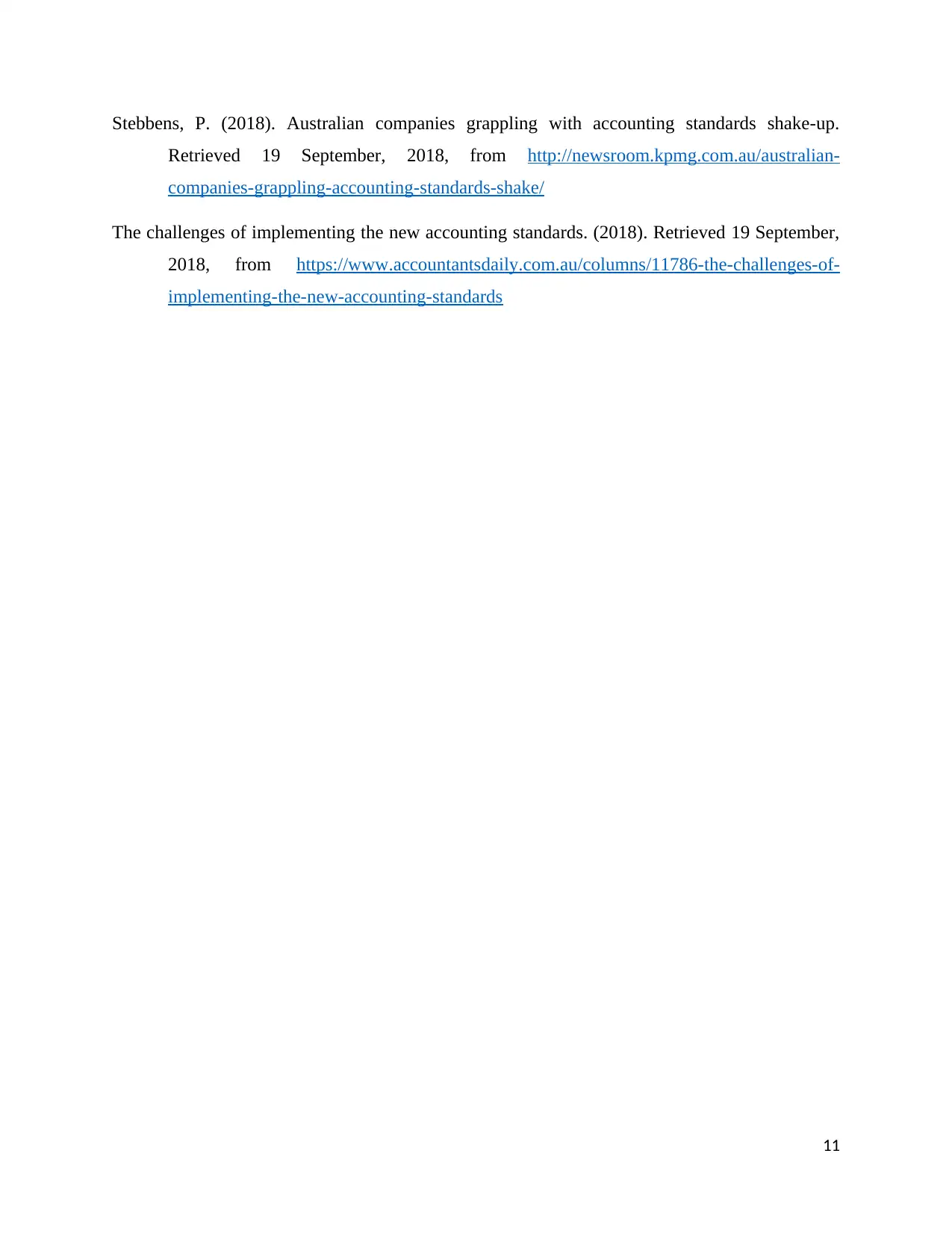
Stebbens, P. (2018). Australian companies grappling with accounting standards shake-up.
Retrieved 19 September, 2018, from http://newsroom.kpmg.com.au/australian-
companies-grappling-accounting-standards-shake/
The challenges of implementing the new accounting standards. (2018). Retrieved 19 September,
2018, from https://www.accountantsdaily.com.au/columns/11786-the-challenges-of-
implementing-the-new-accounting-standards
11
Retrieved 19 September, 2018, from http://newsroom.kpmg.com.au/australian-
companies-grappling-accounting-standards-shake/
The challenges of implementing the new accounting standards. (2018). Retrieved 19 September,
2018, from https://www.accountantsdaily.com.au/columns/11786-the-challenges-of-
implementing-the-new-accounting-standards
11
1 out of 11
Related Documents
Your All-in-One AI-Powered Toolkit for Academic Success.
+13062052269
info@desklib.com
Available 24*7 on WhatsApp / Email
![[object Object]](/_next/static/media/star-bottom.7253800d.svg)
Unlock your academic potential
Copyright © 2020–2025 A2Z Services. All Rights Reserved. Developed and managed by ZUCOL.





